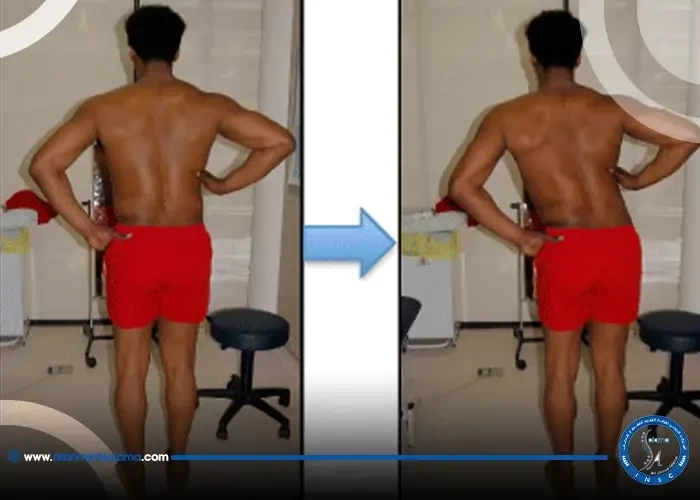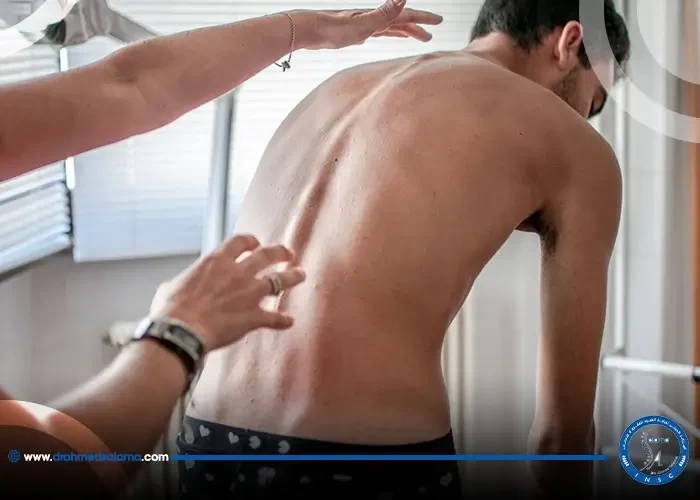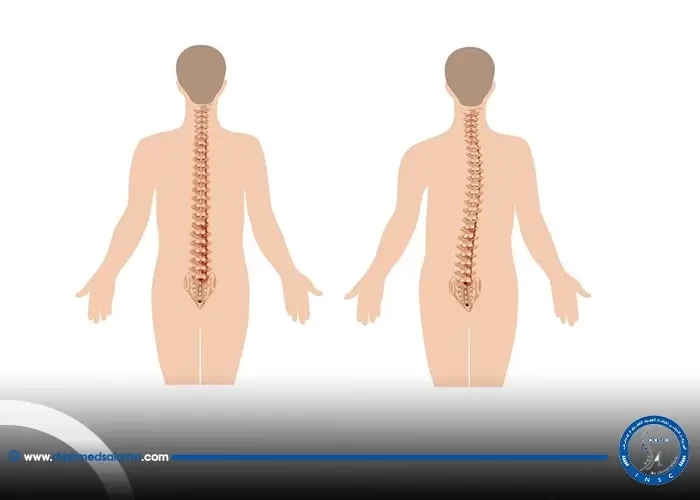Nasr City, 52 El Tayaran Street, in front of the Health Insurance Hospital

The best ways to treat a herniated disc without surgery in 2025

Are you experiencing severe back pain and wondering about the best treatment for a herniated disc? Don't worry, you're not alone. A herniated disc, also known as a "slipped disc," is one of the most common problems affecting the health of the spine, whether in the back or neck. What are the symptoms of a herniated disc in the lower back? Can a herniated disc be treated at home?
In this article, we'll learn about treating a herniated disc in the back in detail, starting with understanding the causes and symptoms, specifically the serious symptoms of a herniated disc and how to deal with them. We'll also show you what a herniated disc looks like in the back, explain the truth about herbal treatment for a herniated disc, and learn how to treat a herniated disc in the neck. Finally, we'll guide you to the best doctor to treat this condition, ensuring you receive comprehensive medical care. Just keep reading to the end.
Back Disc Treatment
Back disc treatment is not limited to a single method. Rather, it varies to include multiple options tailored to each patient's condition and the size and severity of the injury. The most important of these methods include:
Conservative Treatment
Treatment usually begins with a short period of rest to reduce pressure on the vertebrae, while avoiding activities that increase pain. However, prolonged rest should be avoided, as it can lead to muscle stiffness and weakness. Therefore, it is preferable to gradually return to light activity. The doctor may also recommend the use of warm compresses, which help relieve symptoms.
Medication Treatment for Back Disc
The doctor may prescribe some medications to reduce inflammation and relieve pain associated with a herniated disc. These include:
Pain relievers and nonsteroidal anti-inflammatory drugs such as ibuprofen.
Muscle relaxants to reduce spasms.
Neuropathic medications such as gabapentin and vitamin B12 to support nerve health.
Epidural steroid injections to reduce inflammation around the nerves in advanced cases.
Non-Surgical Back Disc Treatment Techniques
In some cases that do not respond to conservative and drug treatment, the doctor may recommend some non-surgical techniques to help treat the disc and relieve pain. These methods include:
Physical Therapy: This includes therapeutic massage sessions and targeted exercises under the supervision of a physical therapist. These help strengthen the muscles supporting the spine, improve flexibility, and relieve pressure on affected nerves.
Ultrasound Technology: This stimulates blood flow to the affected area and accelerates the recovery process, in addition to reducing inflammation and significantly relieving pain.
Electroconvulsive Therapy: This involves sending mild electrical pulses through the skin to the muscles surrounding the spine to reduce pain.
Local Injections: Anti-inflammatory drugs, such as cortisone, are injected into the affected area of the spine to reduce swelling and pressure on the nerves, providing the patient with prolonged relief.
Radiofrequency: An advanced technique that targets the nerves responsible for transmitting pain signals, effectively reducing pain and improving the patient's quality of life without the need for surgery.
Endoscopic Disc Treatment
Endoscopic disc treatment is one of the newest, safest, and most effective medical procedures. It is performed through very small incisions (no more than 1 cm long) without the need for a large surgical incision, thus reducing potential complications. This procedure involves removing the damaged portion of the disc or relieving pressure on the nerves using precise instruments and a sophisticated camera, allowing the patient to return to daily activities in a shorter period of time.
Traditional Surgical Disc Treatment
In advanced cases or when conservative and non-surgical treatments fail to achieve the desired results, the doctor may resort to surgical intervention as a final option to relieve pain and restore spinal function. The most prominent surgical procedures used include:
Laminectomy: A surgical procedure in which a portion of the back bone of the vertebra is removed to relieve pressure on the nerves or spinal cord, helping to reduce pain and improve mobility.
Disc Replacement: The damaged disc is replaced with a flexible artificial disc, which maintains the flexibility of the spine and helps reduce pain.
Spinal fusion: Two or more vertebrae are joined together using metal screws to stabilize the spine and prevent painful movement.
Laser treatment: This involves using laser beams to precisely remove or vaporize damaged tissue, minimizing the surgical incision and speeding up the recovery process.
No matter the severity of your injury or the treatment options for your herniated disc, an accurate diagnosis and a specialized treatment plan are the foundation for a safe recovery. Therefore, don't hesitate to book your consultation with Dr. Ahmed Ibrahim Salama, a consultant neurosurgeon and spine surgeon, to receive advanced care that guarantees greater comfort and safety in restoring your well-being.
Causes of Back Disc Disease
There are many causes of back disc disease. Identifying these causes helps prevent it and facilitates the selection of appropriate treatment. The most prominent factors that increase the risk of developing a back disc disease include:
With age, the cartilage may become less flexible and begin to wear down.
Sudden or incorrect movements, such as bending or lifting heavy weights incorrectly.
Weak muscles supporting the spine due to lack of physical activity or prolonged sitting.
Excess weight, which increases pressure on the vertebrae and intervertebral discs.
Direct injuries or accidents that may affect the integrity of the spine.
Genetic factors, which may increase the susceptibility to disc problems.
Hormonal changes and weight gain during pregnancy in women.
Some strenuous activities that require frequent bending, lifting, or pushing.
Because early diagnosis and appropriate treatment are essential steps to avoid complications, don't hesitate to book a consultation with Dr. Ahmed Ibrahim Salama to receive the latest back disc treatment techniques and comprehensive medical care tailored to your condition.
Lower Back Disc Symptoms
Lower back disc symptoms vary depending on the severity of the condition and the location of the herniation, and may directly impact the patient's daily activities. The most prominent symptoms include:
Lower back pain that may extend to the buttocks or thighs.
Intermittent or constant pain that may last for days or even months.
Pain increases when sitting, bending, or twisting.
Pain improves when lying down or changing position.
Sometimes, a feeling of numbness or tingling in the lower or upper extremities.
Lower back stiffness and difficulty bending or turning.
Muscle weakness and difficulty carrying objects or walking long distances.
In severe cases, problems with urinary or bowel control may occur, requiring urgent medical intervention.
Because addressing these symptoms early makes treatment more effective and easy, don't hesitate to consult Dr. Ahmed Ibrahim Salama, who offers the latest solutions for treating back discs, ensuring you have a precise treatment plan that will help you regain your comfort and return to your normal life safely and efficiently.
Herniated Disc in the Back
A herniated disc in the back appears as a slipped or protruding disc between the vertebrae, putting pressure on the surrounding nerves and causing pain that may extend to the legs or neck. The severity varies depending on the severity of the herniation. Normally, the disc is a flexible disc containing a gelatinous substance that helps absorb shocks and facilitate spinal movement. However, when damaged or torn, its shape changes, directly affecting back movement and nerve health.
Treatment for a herniated disc depends on the degree of herniation and the patient's condition, ranging from conservative treatments such as medication and physical therapy to advanced surgical interventions. Therefore, it is recommended to consult a specialist such as Dr. Ahmed Ibrahim Salama, an expert in neurosurgery and spine surgery, to obtain an accurate diagnosis and develop an effective treatment plan. This will help you regain your health and activity safely.
Serious Disc Symptoms
There are some serious disc symptoms that require immediate medical intervention. They indicate significant pressure on the nerves or worsening of the herniated disc, potentially threatening the ability to move or control bodily functions. The most prominent of these symptoms include:
Loss of bladder or bowel control. Severe weakness or numbness in the legs or arms.
Persistent, sharp pain that does not go away with medication or physical therapy.
Difficulty walking or loss of balance.
Numbness or tingling in the area around the legs and genitals (nausea equina syndrome).
Significant muscle weakness that hinders daily activities.
Sudden worsening of symptoms or partial paralysis of a limb.
Because dealing with these symptoms requires an accurate diagnosis and an advanced treatment plan, it is recommended to schedule a consultation with Dr. Ahmed Ibrahim Salama, who specializes in treating herniated discs using the latest medical technologies.
Home Treatment for Herniated Discs
Home treatment for herniated discs can be an effective option for relieving pain and reducing symptoms in the early stages or in mild cases. However, it requires careful advice and medical supervision to avoid worsening the problem. Some of the most prominent home treatment methods for herniated discs recommended by doctors include:
Take a short rest for a day or two without excessive inactivity.
Avoid sitting for long periods or making sudden movements that increase the pain. Use cold compresses for 10-20 minutes to reduce pain and swelling.
Transition to warm compresses after a few days to relieve muscle spasms.
Consult your doctor about appropriate exercises to strengthen your back and avoid stressful ones.
Choose a medium-firm mattress that supports your spine while sleeping.
While these methods are effective in alleviating disc symptoms in some cases, they do not replace consulting a specialist to develop an appropriate back disc treatment plan for each case. Book your consultation with Dr. Ahmed Ibrahim Salama to receive comprehensive care using the latest advanced techniques to achieve the best results.
Herbal Treatment for Back Disc
Some patients seek herbal treatment for back disc instead of medication or out of fear of surgical intervention, believing that herbs can restore the disc or relieve pressure on the nerves. However, there is no scientific evidence that herbs can treat back discs or repair damaged discs. Although some herbs may help temporarily relieve inflammation or pain, effective and safe treatment must be performed using modern medical methods determined by a specialist physician based on each patient's condition after a thorough diagnosis.
Therefore, don't let these misconceptions delay your treatment or exacerbate your health problem. To avoid any serious complications, book your consultation with Dr. Ahmed Ibrahim Salama to receive an accurate diagnosis and a comprehensive plan based on the latest treatment techniques.
Cervical Disc Treatment
Treatment of a herniated disc in the neck is not much different from treatment of a herniated disc in the back. It requires a precise plan due to the sensitivity of the neck area and its direct impact on the nerves and upper extremities. Treatment usually begins with conservative methods such as rest, avoiding sudden movements, and the use of anti-inflammatory medications and pain relievers, in addition to physical therapy sessions to strengthen the surrounding muscles and improve the flexibility of the vertebrae.
In advanced cases or when pain persists despite conservative treatment, the doctor may recommend non-surgical techniques such as local injections to reduce inflammation, physical therapy, or radiofrequency ablation. Severe cases may require precise surgical intervention using endoscopy or other advanced techniques to ensure the best results with minimal complications.
To obtain an accurate diagnosis and an advanced treatment plan tailored to your condition, it is recommended to book a consultation with Dr. Ahmed Ibrahim Salama to benefit from the latest medical technologies in cervical disc treatment. The Best Doctor for Back Disc Treatment in Egypt
If you're looking for a reliable doctor to treat a herniated disc, Dr. Ahmed Ibrahim Salama, a consultant neurosurgeon and spine surgeon, is the right choice for you, thanks to his extensive scientific and practical experience in this subspecialty. Dr. Ahmed Ibrahim Salama excels at providing accurate diagnoses and a comprehensive treatment plan based on the latest technologies.
He also relies on the use of laparoscopic and microscopic surgical techniques, enabling him to achieve the best results with minimal surgical intervention, a faster recovery period, and less pain, allowing the patient to return to their normal life in record time. He also pays special attention to post-treatment follow-up to ensure the best long-term results.
In conclusion, treating a herniated disc is an essential step toward restoring your activity and normal quality of life, free from pain and complications. Because choosing the right doctor is the most important factor for successful treatment and ensuring a safe and rapid recovery, don't hesitate to rely on Dr. Ahmed Ibrahim Salama, a consultant neurosurgeon and spine surgeon, as he combines extensive experience with the latest medical technologies to provide comprehensive treatment solutions tailored to each case. Don't let pain limit your life. Contact Dr. Ahmed Ibrahim Salama's clinic now to book your appointment.
Is a herniated disc curable?
Yes, a herniated disc can be cured in many cases, especially if diagnosed early and an appropriate treatment plan is followed. This includes conservative treatment, medications, physical therapy, injections, and radiofrequency ablation. In some advanced cases, surgical intervention may be required to achieve full recovery and restore normal movement
What are the restrictions for patients with a herniated disc?
Patients with a herniated disc should avoid lifting heavy weights, sudden bending or twisting, and prolonged sitting. They should also avoid sleeping on uncomfortable surfaces or mattresses that do not support the spine, to reduce pressure on the disc and prevent the condition from worsening






